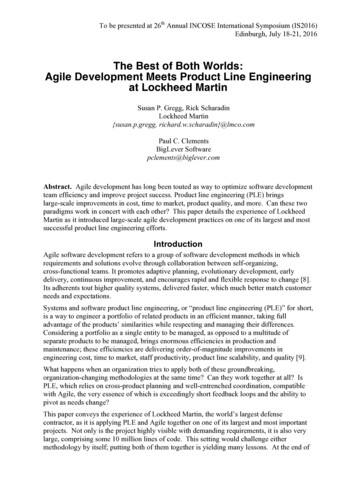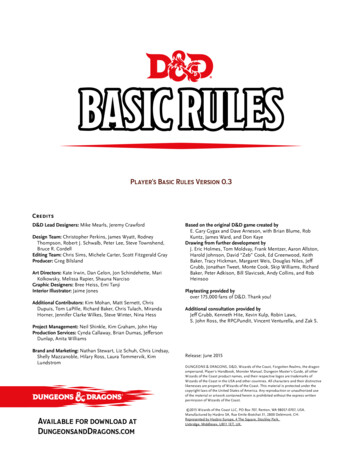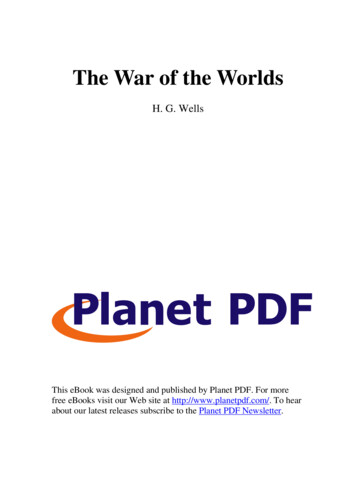
Transcription
To be presented at 26th Annual INCOSE International Symposium (IS2016)Edinburgh, July 18-21, 2016The Best of Both Worlds:Agile Development Meets Product Line Engineeringat Lockheed MartinSusan P. Gregg, Rick ScharadinLockheed Martin{susan.p.gregg, richard.w.scharadin}@lmco.comPaul C. ClementsBigLever Softwarepclements@biglever.comAbstract. Agile development has long been touted as way to optimize software developmentteam efficiency and improve project success. Product line engineering (PLE) bringslarge-scale improvements in cost, time to market, product quality, and more. Can these twoparadigms work in concert with each other? This paper details the experience of LockheedMartin as it introduced large-scale agile development practices on one of its largest and mostsuccessful product line engineering efforts.IntroductionAgile software development refers to a group of software development methods in whichrequirements and solutions evolve through collaboration between self-organizing,cross-functional teams. It promotes adaptive planning, evolutionary development, earlydelivery, continuous improvement, and encourages rapid and flexible response to change [8].Its adherents tout higher quality systems, delivered faster, which much better match customerneeds and expectations.Systems and software product line engineering, or “product line engineering (PLE)” for short,is a way to engineer a portfolio of related products in an efficient manner, taking fulladvantage of the products’ similarities while respecting and managing their differences.Considering a portfolio as a single entity to be managed, as opposed to a multitude ofseparate products to be managed, brings enormous efficiencies in production andmaintenance; these efficiencies are delivering order-of-magnitude improvements inengineering cost, time to market, staff productivity, product line scalability, and quality [9].What happens when an organization tries to apply both of these groundbreaking,organization-changing methodologies at the same time? Can they work together at all? IsPLE, which relies on cross-product planning and well-entrenched coordination, compatiblewith Agile, the very essence of which is exceedingly short feedback loops and the ability topivot as needs change?This paper conveys the experience of Lockheed Martin, the world’s largest defensecontractor, as it is applying PLE and Agile together on one of its largest and most importantprojects. Not only is the project highly visible with demanding requirements, it is also verylarge, comprising some 10 million lines of code. This setting would challenge eithermethodology by itself; putting both of them together is yielding many lessons. At the end of
the day, however, the answer to whether the two methodologies can work in harmony isresoundingly affirmative.This paper will show how Lockheed Martin is using the two methodologies to support eachother, and the lessons it is learning as it does so.What Is Product Line Engineering?Product line engineering (PLE) is a way to engineer a portfolio of related products in anefficient manner, taking full advantage of the products’ similarities while respecting andmanaging their differences. By “engineer,” we mean all of the activities involved inplanning, producing, delivering, deploying, sustaining, and retiring products.Born in the 1980s in the software field, but now having grown well beyond those early roots,PLE offers large savings observed from engineering the whole family rather than separatelyengineering each member. Numerous case studies [1][4][5][10][14][15] show that exploitingthe commonality throughout the products’ total life cycles can return substantialimprovements in time to market, cost, portfolio scalability, engineer productivity, andproduct quality [13]; no other engineering paradigm shift has, to our knowledge, broughtabout results that rival these.PLE as a FactoryAn analogy with factory-based manufacturing serves to illuminate the important concepts.Manufacturers have long used engineering techniques to create a product line of similarproducts using a common factory that assembles and configures parts to produce the varyingproducts in the product line. For example, automotive manufacturers can create thousands ofunique variations of one car model using a single pool of parts carefully designed to beconfigurable and factories specifically designed to configure and assemble those parts.In PLE, the configurator is the factory’s automation component; the “parts” are the assets inthe factory’s supply chain. A statement of the properties desired in the end product tells theconfigurator how to configure the assets.Figure 1 illustrates. This factory’s supply chain is at the left, in the form of shared assets thatare configurable because they include variation points that are expressed in terms of thefeatures [8] available in each of the products. A product specification at the top tells theconfigurator how to configure the assets coming in from the left. The resulting products,assembled from the configured assets, emerge on the right. This enables the rapid productionof any variant of any of the assets for any of the products in the portfolio. Once thisproduction line capability is established, products are instantiated – derived from the sharedassets – rather than manually created.The products in the portfolio are described by the properties they have in common with eachother and the variations that set them apart. The products can comprise any combination ofsoftware, systems in which software runs, or non-software systems that havesoftware-representable artifacts (such as requirements, engineering models, or developmentplans) associated with the engineering process that produces them.In this context “product” means not only the primary entity being built and delivered, but alsoall of the artifacts that are produced along with it. Some of these support the engineeringprocess (such as requirements, project plans, design modes, and test cases), while others aredelivered alongside the thing being built (such as user manuals, shipping labels, and partslists). These artifacts are the product line’s assets.
Assets can be whatever artifacts are representable digitally and either constitute part of aproduct or support the engineering process to create a product. Four kinds of shared assetsare shown in Figure 1, but those are just examples. Shared assets can include, but are notlimited to, requirements, design specifications, design models, source code, build files, testplans and test cases, user documentation, repair manuals and installation guides, projectbudgets, schedules, and work plans, product calibration and configuration files, data models,parts lists, and more. Assets in PLE are engineered to be shared across the product line.Figure 1: PLE as a factory.PLE Contrasted With Product-Centric DevelopmentPLE stands in contrast to traditional product-centric development, in which each individualproduct is developed and evolved independently from other products, or (at best) starts out asa cloned copy of a similar product that is then changed to suit the new product’s specificneeds. Product-centric development takes very little advantage of the commonalities amongproducts in a portfolio after the initial clone operation. In particular, it derives very littlebenefit from commonality in a product’s sustainment or maintenance phase, where datashows most products consume up to 90% of their project resources.Figure 2 shows a production shop in which N products are developed and maintained. In thisstylized view, each product comprises requirements, design models, source code, and testcases. Each engineer in this shop works primarily on a single product. When a new productis launched, its project copies the most similar assets it can find, and starts adapting them tomeet the new product’s needs.To see how this form of reuse can lead to intractable complexity, assume that a defect isfound in Product B, and that the defect is traced to an ambiguous or incorrect requirement inProduct B’s requirements. The Product B team fixes the error, re-designs as necessary, thenfixes the code and test cases before re-deploying Product B. Product B is now healthy again.
But suppose that the defect in Product B’s requirements was “inherited” when the Product Bteam copied the requirements from Product A. Suppose further that the source code forProduct N was copied from Product B’s (defective) source code, and the test cases forProduct N were similarly “borrowed” from Product A’s (inadequate) test cases.Figure 2: Product-centric development yields O(N2) complexityTo really root out the defect from the entire portfolio, each of the N product teams shouldreally confer with each of the other N-1 product teams. These communication paths areshown in red in Figure 2. This communication obligation imposes an overhead that grows asthe square of the number of products. This complexity will quickly overwhelm anyengineering staff; in order to get their products out the door on time and on budget, eachproduct team will focus more on their product silo and less on taking advantage of thecommonalities and interdependencies among the other products. The result is divergentproduct silos, low degrees of sharing, and high duplication of effort across the product silosto fix the same defect multiple times in multiple products, or to independently implement thesame enhancements in different ways in different products.Figure 1 alluded to PLE as a factory, and that analogy can be brought to bear to remedy theO(N2) problem of portfolio management. In a manufacturing factory, a defective productwould not be fixed by one-off repairs to the product itself. Rather, the factory, its supplychain, and the manufacturing process itself would be scoured to find the source of the defect.So it is with PLE. Rather than fix a defective product, PLE engineers fix the shared asset(s)that need to be modified (perhaps by adding a new variation point) in order to produce theproduct correctly. Then, the configurator is used to re-generate the product, as well as anyother product affected by the changes in the shared assets. Since re-generation has a low andfixed cost, it matters very little whether 2 or 200 or 2000 products need to be re-generated.Thus, fixing a defect, making a systematic enhancement, or carrying out any other kind ofportfolio-wide change becomes an O(N) operation.
Product Line Engineering at Lockheed MartinA product line of product linesLockheed Martin has for some years now been developing one of its flagship products for theUS Government as a product line, using the PLE factory paradigm described earlier. By nowthe PLE processes and teams are mature and experienced, and view their primary objective asdeveloping once, and building and deploying many times from one set of common assets –principally requirements, source code, and tests. Feature-based variation in requirements andcode enables building a member of the product line with or without a specific capability.First, some terminology that has emerged from their PLE approach: Lockheed Martin calls a member of its product line a configuration. A configurationmight be, for example, an instance of the system to be deployed to a specific site. Theproduct line approach, then, exists to produce configurations for customers. Thisproduct line we are writing about comprises roughly 100 such configurations. Each configuration that Lockheed Martin deploys to its final operational comprisesnine major software components, working together to achieve the functionality of thefull system. These software components are, in the context of their developmentprojects, are called products1. The variation in the systems, then, manifests itself asvariation within each of the products.Each product is developed as a product line – a mini-“factory” – in its own right.Accordingly, each product has a team associated with it, and is managed as a project, withbudgets and development schedules that must play into the budgets and schedules of thesystems at large. Thus, the overall product line is actually a product line of product lines. Afeature profile for the entire system is actually a set of feature profiles, each describing adesired configuration of one of the products (components).The coarsest-grained variation point is to include or exclude an entire component dependingon whether or not the feature(s) provided by that component are included in a configurationor not. If a component is included, it can be further varied by exercising variation pointsinside, again based on feature choices.For requirements, the product line employs a common specification repository (a DOORSdatabase) that contains all requirements for all configurations, with varying requirementscaptured in feature-based variation points. This model allows for multiple configurations toshare requirements while having the flexibility for each configuration to have uniquerequirements as well.During the test and verification phase, the product line utilizes a consolidated testingapproach to maximize efficiency of common requirements and capabilities. This results intailored regression testing based on changed functional area. An integrated test team alsouses common test plans and procedures. Common test efforts are leveraged and consolidatedproblem reporting avoids duplicate reporting caused by redundant testing – all part of thePLE factory approach.1This is a different definition of “product” than appeared in the introductory section on PLE. There, it meant a finaldeliverable, a complete system. Here it refers to a component of a complete system.
Product line governanceBecause of the size, importance, and visibility of the product line, governance of the productline has emerge as a major issue. Stakeholders include multiple agencies of the USGovernment, inside and outside of the Department of Defense. They, and Lockheed Martin,had to create a number of governance structures, artifacts, and policies, to coordinate andprioritize the various and (at times) competing interests in each of the configurations, as wellto head off confusion around who in the government was giving direction to LockheedMartin, by what authority, and what direction was being provided [6].Some of the more germane facets of governance include: Regular, predictable build rhythm. There are three build releases a year, one ineach of January, May, and September. This so-called “1-5-9” rhythm brings greatstability to the program. Everyone, inside Lockheed Martin or out, can expect andplan for the next release. Inside Lockheed Martin, build meetings are held weekly, tomake sure the next release is on track. Not every customer configuration in theproduct line is required to accept every release; each makes its own decisionaccording to operational needs and the content of the particular build. Requirements review cycle. As in all product lines, changes to requirements(whether to add new capabilities or address defects) that are made for oneconfiguration may have intended and unintended impacts to other configurations, andmust be reviewed across the product line with that in mind. A rigorous RequirementsReview Cycle for programs is held in March, July, and November (a “3-7-11”rhythm) and is a joint Lockheed Martin/customer exercise. Governance boards. While Lockheed Martin worked to establish processes tomanage a coordinated planning approach and day-to-day development activities toserve multiple masters, the government put in place a structure and associatedprocesses to ensure clear and consistent direction is being provided to maximize theprobability of success for all programs. This structure provides support for decisionmaking at three levels: Strategic, Programmatic, and Technical. These boardsadjudicate cross-program priorities and activities. Their respective decisions arecaptured in a Development Fielding Plan, a Branch and Merge Plan, and a Build Plan.If a program introduces an upgrade or new capability, it pays for it. Other programs are freeto pick it up, or not, as they wish, but they pay for any testing that is required and unique totheir context. After a development is complete and time has elapsed, newly found defectsbecome difficult to associate with any one program. In these cases all programs pitch in topay to have the defect corrected. Lockheed Martin gets a special funding account to fix alldefects, across the entire product line, that are not related to unique capability content indevelopment. Any program receiving special development funding pays for defects in thatdevelopment, up to its demonstration milestone, at which point the cost-sharing approachkicks in.This, then, is the institutionalized PLE situation at Lockheed Martin when Agile joined thepicture. As we shall see, some of these governance structures have been key to a seamlessAgile integration.Agile DevelopmentAgile software development is a group of software development methods in whichrequirements and solutions evolve through collaboration between self-organizing,cross-functional teams. It promotes adaptive planning, evolutionary development, early
delivery, continuous improvement, and encourages rapid and flexible response to change[16].Although are many specific agile development methods, all rely on a small number offundamental concepts: Iterative, incremental and evolutionary. Most agile development methods breakthe tasks into small increments with minimal planning and do not directly involvelong-term planning. Iterations are short time frames that typically last from one tofour weeks. Each iteration involves a cross-functional team working in all functions:planning, requirements analysis, design, coding, unit testing, and acceptance testing.At the end of the iteration a working product is demonstrated to stakeholders. Efficient and face-to-face communication. Each agile team should include acustomer representative (called the “product owner” in the scrum methodology). Thisperson is appointed by stakeholders to act on their behalf and makes a personalcommitment to being available for developers to answer mid-iteration questions. Very short feedback loop and adaptation cycle. A common characteristic in agile isthe daily "stand-up", also known as the daily scrum. In a brief session, team membersreport to each other what they did the previous day toward their team's sprint goal,what they intend to do today toward their team's sprint goal, and any roadblocks orimpediments they can see to their team's sprint goal. Quality focus. Specific tools and techniques, such as continuous integration,automated unit testing, pair programming, test-driven development and othertechniques are often used to improve quality and enhance project agility.ScrumScrum is the specific agile approach chosen by Lockheed Martin. It provides a structure ofroles, meetings, rules, and artifacts. Teams are responsible for creating and adapting theirprocesses within this framework. Scrum uses fixed-length iterations, called sprints, whichare typically 1-2 weeks long.A key principle of scrum is its recognition that during production processes, the customerscan change their minds about what they want, and that unpredicted challenges cannot beeasily addressed in a traditional predictive or planned manner [17].There are three core roles defined in the scrum framework [17]: Product owner. The product owner represents the stakeholders and is the voice ofthe customer. The product owner writes (or has the team write) customer-centricitems (typically user stories), ranks and prioritizes them, and adds them to the productbacklog. The product owner should be on the business side of the project, and shouldnever interfere or interact with team members on the technical aspects of thedevelopment task. Development team. The development team is responsible for delivering potentiallyshippable increments of product at the end of each sprint. A team is made up of 3–9individuals who do the actual work (analyze, design, develop, test, technicalcommunication, document, etc.). Development teams are cross-functional, with all ofthe skills as a team necessary to create a product increment. The development team inscrum is self-organizing, even though there may be some level of interface withproject management offices.
Scrum master. Scrum is facilitated by a scrum master, who is accountable forremoving impediments to the ability of the team to deliver the product goals anddeliverables. The scrum master is not a traditional team lead or project manager, butacts as a buffer between the team and any distracting influences. The scrum masterhelps ensure the team follows the agreed scrum processes, often facilitates keysessions, and encourages the team to improve.A sprint is the basic unit of development in scrum. The sprint is a time boxed effort; that is, itis restricted to a specific duration. The duration is fixed in advance for each sprint and isnormally between one week and one month, with two weeks being the most common.Each sprint starts with a sprint planning event that aims to define a sprint backlog, identifythe work for the sprint, and make an estimated commitment for the sprint goal. Daily scrummeetings are held to assess progress and identify impediments to reaching the sprint’s goals.Each sprint ends with a sprint review and sprint retrospective, that review progress to show tostakeholders and identify lessons and improvements for the next sprints. [17]Agile Comes to Lockheed MartinLockheed Martin has been able to achieve hundreds of millions of dollars in cost avoidancefrom their successful application of PLE [7]. But in late 2014, corporate managementdecided that Agile was the way to strengthen Lockheed Martin’s competitive positionthrough quality and affordability. This goal was levied on the entire organization, including,for example, Lockheed Martin’s Orion spacecraft project, which involves some 350engineers. Training began throughout the corporation in March, 2015.Improvement measures for Agile are somewhat hard to come by, but the Standish Groupclaims that Agile projects are three times as successful as Waterfall projects (Figure 3).Others say “the use of agile methods results in increased cost-effectiveness, productivity,quality, cycle-time reduction, and customer satisfaction ranging from 10% to 100% [11].Figure 3: Agile projects are three times more successful than Waterfall projectsaccording to the Standish Group.
These and other ROI results motivated the adoption of Agile. It fell to those parts of theorganization already addressing competitiveness through affordability and quality with PLEto work out how to add Agile to the mix, and achieve still more.Melding Agile and PLEAgile is, by and large, about a (usually small) single product fielded by a single (usually small) organization by one or more (always small) teams in a series of extremely short iterative development cyclesIn the product line being described: The products – plural – are large by any standard, comprising some 10 million lines ofcode and costing tens to hundreds of millions of dollars. The teams, spread across the products, are sizable. The largest component, forexample, involves over 200 engineers. Some 800 engineers are involved in theproduct line overall2. The build cycles, under the product line’s 1-5-9 build tempo, are four months long.How can these very different approaches be integrated?Lockheed Martin’s first answer was “incrementally.” Figure 4 outlines a three-year phasedapproach to bring in Agile practices. The first phase concentrates on risk reduction, training,and release planning; the first release planning event was completed only a few weeks beforethis paper was submitted. The second phase continues to roll out and begins to to optimizeworkflows and team organizations that were put into place in the first phase; it also begins tore-define some of the customer interactions that need to change, such as adapting tofiner-grained scheduling and budgeting and providing more embedded feedback. Finally, thethird phase continues the roll-out, incorporates business coordination, and transitions fromintroduction to optimization.But the question remains: How to bridge the gap between large-scale PLE and small-scaleshort-iteration Agile? Here there are three answers, each detailed in a sub-section below.Small projectsAgile in general, and Scrum in particular, are about the lean execution of developmentprojects. In the subject product line, projects are associated with component products. Thatis, the projects are already defined. The goal, then, became making those projects Agile. Thatin turn involved making the project teams into small, Agile teams working in short iterationsto support small-scale tasks that, taken as a whole, sum up to the purpose and work of theoriginal product teams.2This product line turns out to be the largest application of Agile in the entire corporation.
Figure 4: Lockheed Martin's three-year three-phase approach to incorporate AgilemethodsSmall teamsSmall teams resulted from decomposing the products’ large teams into Scrum teams of sizeseven to ten. The teams, considered together, do the same work as they did before, but thework has also been divided into smaller bite-sized chunks that match the team size and shortiteration (sprint) schedule.The teams are self-organized by product, mostly around areas of domain expertise orfunctionality, or around specific elements in the architecture. Figure 5 describes theessentials of individual teams.Figure 5: Scrum teams
So far so good: Decomposing large teams into small ones, and large tasks into small tasks, isrelatively straightforward.However, instead of nine large product teams, the decomposition resulted in 100 or so smallones. Further, the twelve major configurations are, at any point in time, each in a differentphase of development. For some, the major activity for the next release is writing conceptpapers; for others it might be writing code; for still others, it could be testing. Coordinatingthese activities among nine large teams was challenge enough; with 100 small teams,ensuring everyone is working towards common large-scale goals, without devoting all theirtime to management overhead tasks, becomes a concern of the first order.This issue is Ground Zero of where PLE meets large-scale multi-project Agile.To address this problem, Lockheed Martin has turned to the Scaled Agile Framework(SAFe), a “knowledge base for implementing agile practices at enterprise scale.” It definesthe “individual roles, teams, activities, and artifacts necessary to scale agile from the team, toteams of teams, to the enterprise level.” [12]Dependencies are tracked using Atlassian’s Jira software project and issue tracking tool. Jirahelps plan and manage sprints, and it allows every team member to be involved in theplanning. This involvement lets everyone see and be aware of task dependencies, and leadsto more accountability, ownership, and buy-in to the team’s tasking. Teams votecollaboratively to agree on the scope of a piece of work. If priorities are not being met, thenthe higher-level governance structures describe earlier for the product line as a whole comeinto play to adjudicate conflicts and re-orient the work.This agile management of teams also provides flexibility in work assignments. A team withmore resources and less schedule pressure at the moment can “farm out” their services toother teams in need.This approach, using SAFe, received its first serious trial this past September with theproduct line’s first full-up release planning event. All 100 teams, representing all 800engineers, participated in this 3-day planning exercise and produced a coordinated plan forthe next eight weeks. Jira provided the way to manage links among program and productwork content, and all 800 engineers (many geographically dispsered) could see this pictureunfolding in real time.Small iterationsWhile inter-team coordination is squarely in the realm of SAFe, work inside each teamfollows classic Scrum, meaning that planned work is organized into two-week sprints. Acertain number of sprints add up to a release.How many sprints? Recall from our overview of product-line-level governance thatLockheed Martin has adopted a four-month release cycle referred to as their “1-5-9” rhythm.Thus, eight sprints constitute a release. Here is an elegant case where PLE and Agile work insynchronization with each other.The work accomplished in each sprint is, again from Scrum, defined in terms of user stories.A user story is a “developer-sized” task that can be implemented and tested in one or twodays. It constitutes the smallest capability that has business value.User stories may be decomposed into tasks, which generally take 2-8 (worst case, 16) hoursto complete.
Users stories are used to accomplish features. A feature is a sort of large-scale user story thatoften applies to an entire release. A feature is accomplished within a release cycle, and oftenspans teams in its scope.Features in turn constitute epics, a capability that spans multiple releases (perhaps even overmultiple years) and often involves the addition of major capability to the product line.Figure 6 summarizes.Operationally, each product team takes a program feature and decomposes it into features thataffect their product. These product features are then decomposed into user stories and tasks.These constitute the team’s backlog. The work under this approach is by and large what itwould have been under the “pure” PLE approach, except that now it is decomposed intoassignments that can be agilely managed with greater precision and predictability, andallowing for a much finer-grained prioritization.Figure 6: Epics, features, user stories, and tasksFollowing Scrum prescription, each sprint includes daily scru
Agile software development refers to a group of software development methods in which requirements and solutions evolve through collaboration between self-organizing, cross-functional teams. It promotes adaptive planning, evolutionary development, early delivery, continuous improvement,











